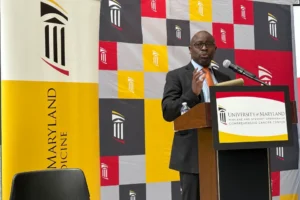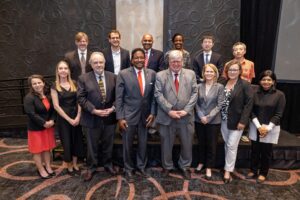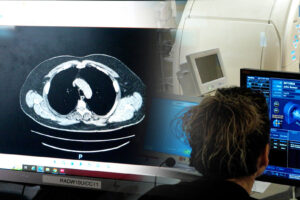University of Maryland, county officials sign $40M agreement to bring health computing center to North Bethesda

Published 11/11/22 in Bethesda Magazine | Bethesda Beat
Montgomery County, state and federal officials joined partners from University of Maryland’s medical system in North Bethesda to sign an agreement Thursday that establishes a health computing center to North Bethesda.
According to the memorandum of understanding, the county is providing $15 million in fiscal year 2023 — and $5 million in each of the following years, through fiscal year 2028. The agreement also states that $3 million will be needed from the federal government for fiscal year 2023.
County officials and University of Maryland Medical System officials said during a embargoed news briefing with reporters on Wednesday that the agreement would be a game-changer for the region, as it builds on the life sciences core within Montgomery County.
County Executive Marc Elrich (D) and University of Maryland Health System officials from across the institution’s multiple campuses said the center will help create a space for research and studies across computing, outside of the traditional wet lab spaces seen in other parts of the county and region. It also will feature artificial intelligence and related technologies, officials said.
The institute will be located near the North Bethesda Metro station.
It will focus on health computing, using virtual and augmented reality, and connecting with local federal health institutions to “catalyze a clinical data science ecosystem at North Bethesda that draws FDA and NIH investigators, and faculty, medical bioinformatic educational programs and students, and industry partners, allowing expansion of computational ‘dry’ laboratories, virtual meeting rooms and classrooms,” according to the agreement
“The work that they’re going to be doing is of national significance,” Elrich told reporters during an embargoed press briefing on Wednesday. “This isn’t a small college doing an interesting small college project, this is the kind of work that is transformational.”
Dr. Amitabh Varshney, Dean of the University of Maryland’s School of Computer, Mathematical and Life Sciences, said the facility would directly employ about 100 people, including investigators (grant providers), researchers, data scientists, visualization experts and students.
The investigators are important, because they can bring considerable grant money to do important research in the field, whether it be in cancer research or helping diagnose and treat long-term issues, like kidney failure, said Dr. Mark Gladwin, dean of the University of Maryland Baltimore’s School of Medicine.
Gladwin said about 30 percent of the money to run institutes like this one is “hard money,” meaning direct government money and other start-up funds.. The remaining funds come from the investigators who want to offer grant money to pursue specific research, he said.
There’s been interest from pharmaceutical companies, health care companies and consulting companies, to get involved in the project, Gladwin said.
Elected officials and university partners spoke during a signing of the memorandum of understanding atop the rooftop at 909 Rose Avenue, as construction workers hammered away at building a high rise office building across the street.
University of Maryland Medical System President and CEO Mohan Suntha said the agreement is what can occur when local government and university partners share a common vision.
“We very proudly describe ourselves because of this partnership as a health system that is an academic health system,” Suntha said. “What that really means is that we take on the responsibility of thinking about today and defining the chores of tomorrow. While we are delivering the care today, we take on the responsibility of educating the future healthcare workforce.”
County Council Vice President Evan Glass said the agreement is a microcosm of how far the North Bethesda area has come in recent decades.
“Just a few years ago, this used to be a big parking lot with a Toys R Us, and look at it now,” Glass said.
It’s uncertain what office space the institute will be in, but Glass and other elected officials said it will hopefully help spur future development, including near the North Bethesda Metro station.
Liz Price, vice president of real estate and parking for WMATA, told Bethesda Beat in an interview that the agreement for the institute is important because it secures $10 million for infrastructure improvements needed for mixed-use development on the 12 acres next to the station. That will be used for things like sidewalk and road improvements, Price said.
Price added that WMATA envisions some sort of mixed-use development on its property. With the agreement, it’s not unreasonable to expect some sort of project happening in the next five to 10 years, she said.
Bill Tompkins, president/CEO of the Montgomery County Economic Development Corp., said that the institute should also spur further opportunities in the hospitality sector, general health care industry, cybersecurity companies, and nonprofit arena.
Tompkins said Elrich deserved a lot of credit for the agreement, despite some political opponents saying economic development is not his greatest strength.
“When you think about the complexities of our university system, where you’ve got multiple partners — getting them aligned is not a slam dunk,” Tompkins said. “You have to give Marc Elrich another degree today as our economic development leader. Because even though his reputation is that it’s not his primary focus, he personally made a lot of this happen.”



